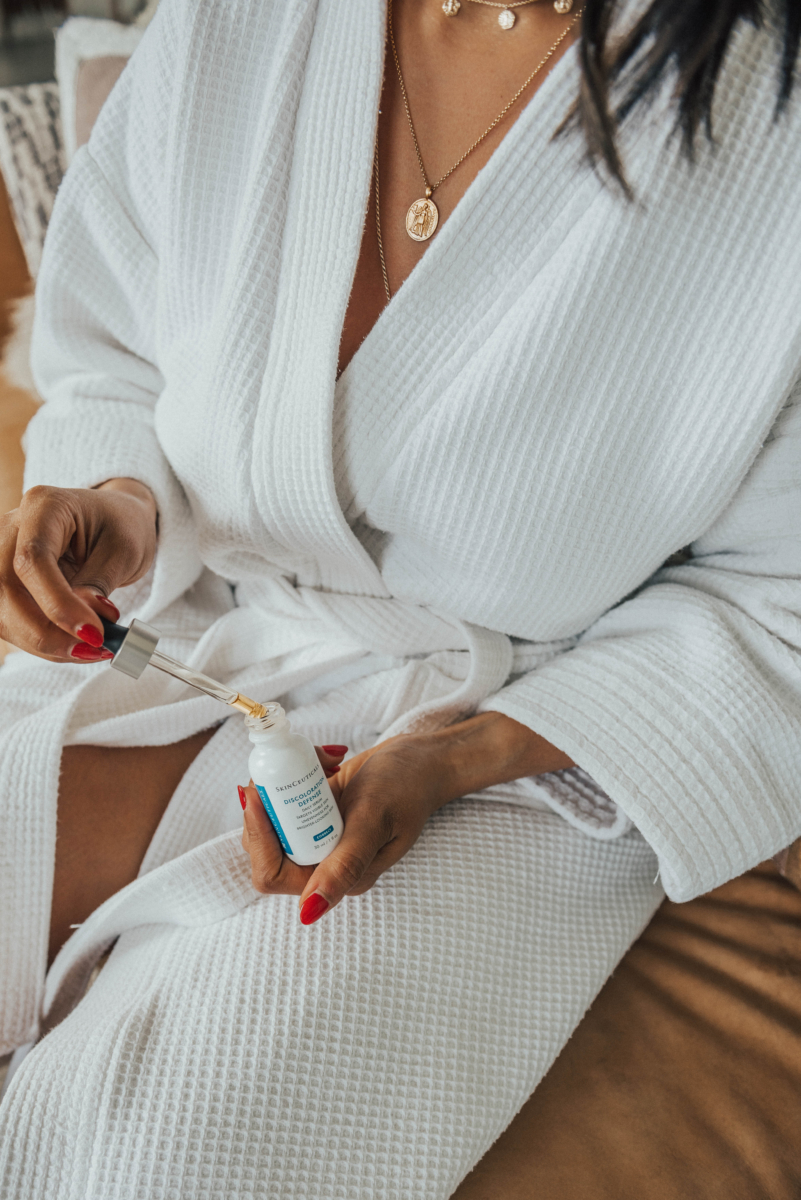
Every now and then, a new skincare ingredient comes up that becomes too buzzy to ignore. Niacinamide is one such ingredient. I kept stumbling upon it over and over again, so I figured it was time to get my Sherlock on and do some digging.
What made me pay attention to Niacinamide was when I realized it was a key ingredient in the Skinceuticals Discoloration Defense. Now I’ve spoken about Skinceuticals before. It’s a medical-grade brand that delivers serious results. In fact, I interviewed their scientific lead about Vitamin C. Not to mention, their products have transformed my skin completely. So when a brand of such great stature uses an ingredient in one of their correction products, I take notice.
First things first, I wanted to try the Discoloration Defense to see what it did for my skin. Not joking, but the rate at which this thing corrects hyperpigmentation/scarring is unbelievable. I used it in conjunction with a few other brightening products and the scars I had from a breakout in December have basically disappeared.
So once I knew I loved the product, I decided to interview Chloe Smith, the Scientific Communications Lead at Skinceuticals once again. I wanted the dirt on Niacinamide. What is it, how it works, and everything in between.
S: What is Niacinamide?
C: Niacinamide is the water-soluble version of Vitamin B3. It is one of eight B-complex vitamins that can be found in foods like avocado and salmon.
S: What’s the difference between Niacinamide and Niacin?
C: Niacin (or nicotinic acid) is Vitamin B3. Every part of your body requires niacin to function properly. Orally, niacin can lower cholesterol, boost brain and nervous system function, and even relieve joint pain. However, large doses of niacin can cause a ‘niacin flush’ where small blood vessels in your skin dilate, so you appear red temporarily.
Unlike niacin, niacinamide does not lower cholesterol orally nor does not produce the flushing effect. However, niacinamide can penetrate the skin and has a good tolerability level, making it ideal for topical use.
S: What does Niacinamide do when applied topically? How exactly does it work?
C: When applied topically, niacinamide can improve skin texture and strengthen the protective skin barrier – this typically looks like dry, irritated skin. It does this by preventing water loss in the epidermis and producing good lipids in your skin. Niacinamide can also reduce pigmentation and improve cell turnover, which improves the appearance of aging skin.
S: What makes the Skinceuticals Discoloration Defense special?
C: SkinCeuticals Discoloration Defense uses 5% niacinamide, which is the optimal dosage for niacinamide to be effective on pigmentation / dark spots. The product blends together other active ingredients like kojic acid and tranexamic acid that work on different pathways involved in excess pigmentation production. This blend of niacinamide, kojic acid, and tranexamic acid work synergistically to improve the appearance of stubborn types of pigment like melasma and post-inflammatory hyperpigmentation.
S: Both the Skinceuticals Vitamin C Serums and the Discoloration Defense work to brighten skin. What are the key differences between Vitamin C and Niacinamide?
C: Vitamin C is the most important antioxidant for human skin because it prevents damage caused by sunlight – the leading cause of photoaging and skin cancer. Vitamin C also increases collagen production to decrease wrinkles and it evens out blotchy skin tone. Think of Vitamin C like a sunscreen – it is the most essential step in your skincare routine for the maintenance of good skin health long-term.
Niacinamide is more effective on stubborn types of pigmentation that appear as dark brown spots or patches. Niacinamide is also effective at strengthening the skin’s protective barrier, which reduces redness.

S: Should the Discoloration Defense be used in the morning or night? Why?
C: Discoloration Defense is recommended for both morning and nighttime use. 2x daily application provide the results demonstrated in the supporting clinical evidence on the product (a 60% improvement in melasma, and an 80% improvement in PIH). You can use this product safely 2x daily because the product is very well tolerated on all skin types, and the ingredients do not cause skin sensitivities.
S: Can you use an acid (like glycolic or salysilic) in conjunction with the Discoloration Defense?
C: You can safely use glycolic or salicylic acids together with Discoloration Defense. Doing so will further improve skin texture and smoothness. I recommend SkinCeuticals Blemish + Age Defense because it blends glycolic and salicylic acid together, and treats both active acne and wrinkles. If you pair this together with Discoloration Defense, you will see acne scars and inflammation fade faster.
S: If someone is really concerned with hyper pigmentation, what are some products, you’d recommend for a high-impact brightening routine?
C: The other super-star product for hyperpigmentation is Retinol. I recommend SkinCeuticals Retinol 0.3 for first time users of cosmeceutical-grade retinol. This product effectively regulates melanin production. It can cause temporary side effects like minor peeling and redness, but this usually subsides in a few weeks. The temporary side effects are worth it when you see your pigment disappearing fast!
To maintain the glow and further brighten the overall skin tone, try SkinCeuticals Metacell B3. It is a corrective moisturizer formulated with 5% niacinamide, just like Discoloration Defense. The hydrating formula maintains good skin firmness, while the niacinamide improves skin tone and texture.
PS – check out the 411 on Squalane and the right way to layer skincare.